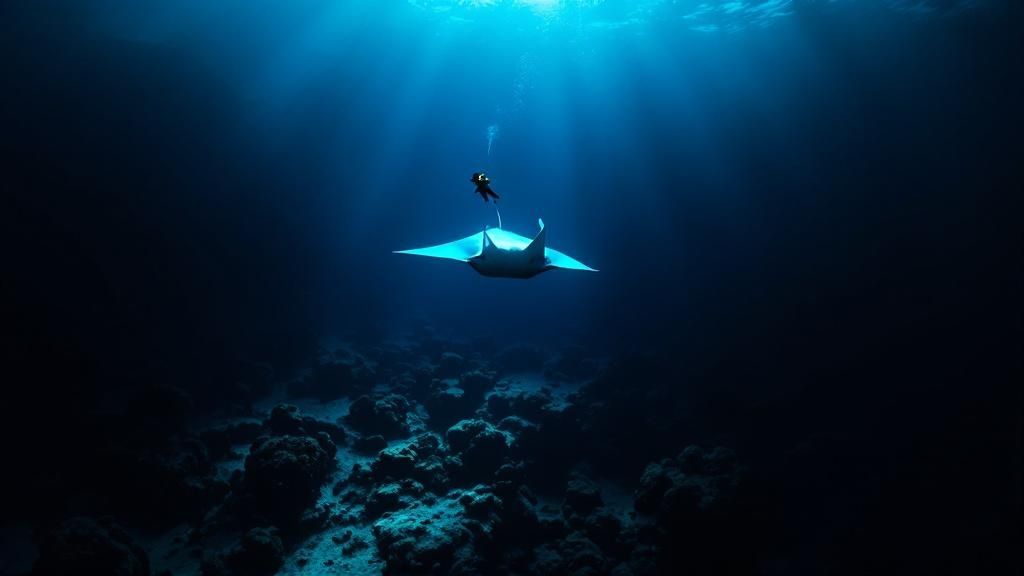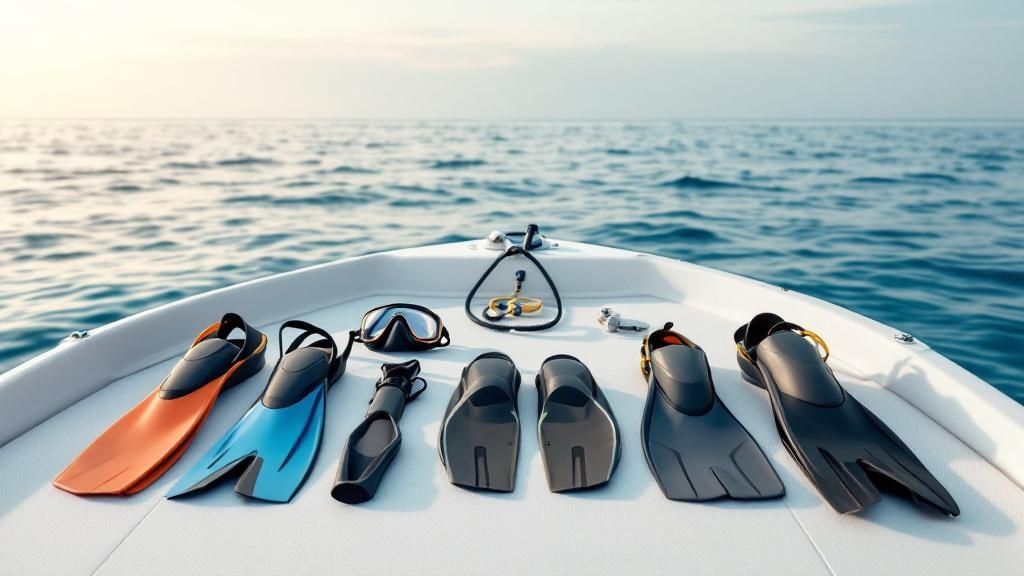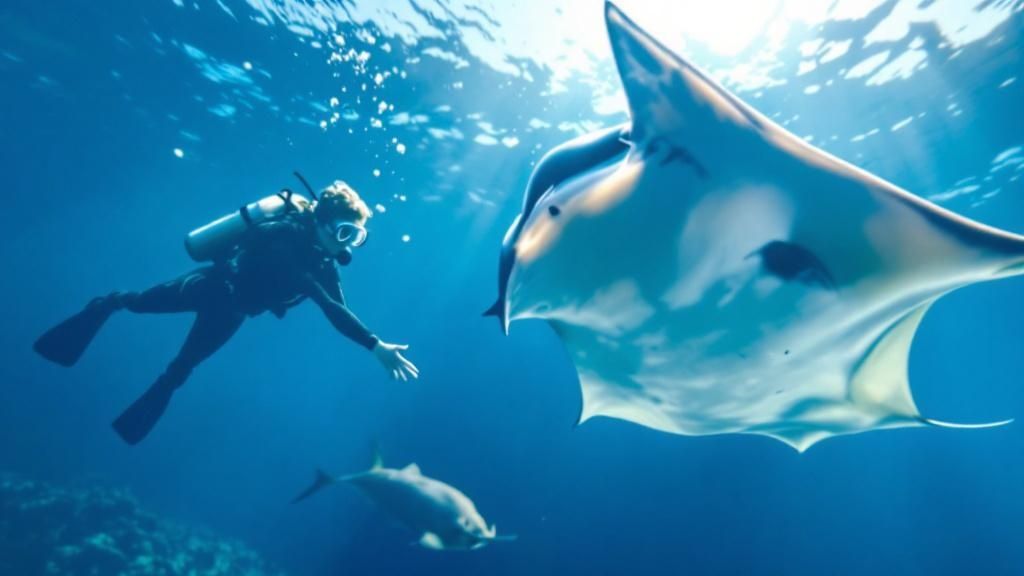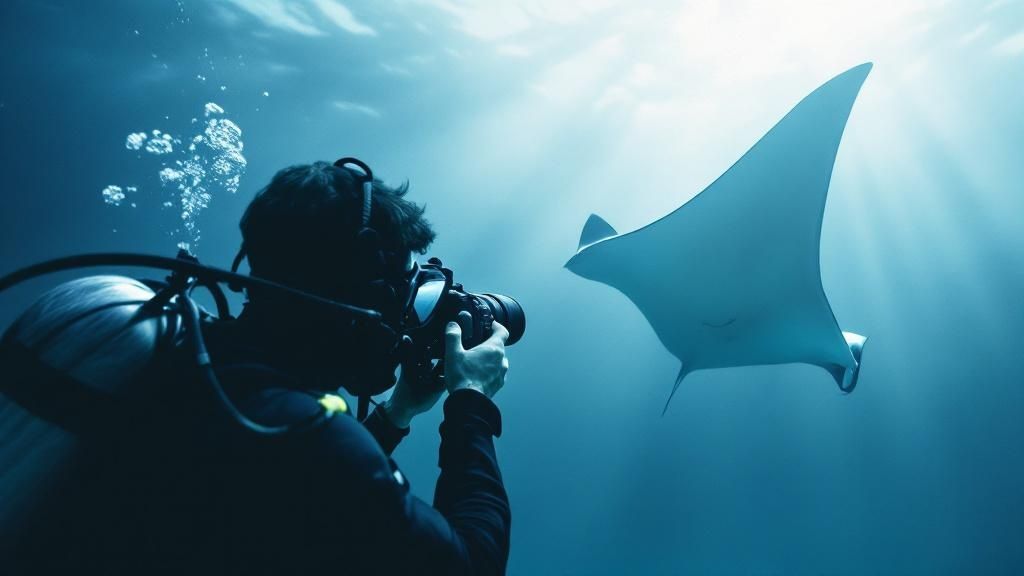Picture this: you're suspended in the warm, dark waters of the Pacific Ocean. Suddenly, a colossal, gentle creature with a wingspan wider than a car swoops in, gliding and barrel-rolling just inches from your face. This isn't a scene from a documentary—it's the world-famous manta ray dive kona, an experience so magical it feels surreal. It is, hands down, one of the most unforgettable underwater encounters you can have anywhere on the planet.
Why the Kona Manta Dive Is a Bucket-List Must
The Kona coast of Hawaii isn't just another pretty dive spot. It's globally famous as the single most reliable place on Earth to see manta rays up close. How? Specific locations have become natural, all-you-can-eat buffets for these gentle giants, and they show up almost every single night to feast.
This remarkable consistency has turned the area into a premier destination for sustainable marine tourism, drawing around 80,000 visitors each year just for this adventure. This isn't a "maybe you'll see one" kind of dive. The entire experience is set up for incredibly close encounters. Dive operators place powerful lights on the ocean floor or on a floating "campfire," which attract swarms of plankton—the mantas' favorite food. The mantas then arrive to perform an effortless underwater ballet, scooping up mouthfuls of their dinner.
Kona’s Legendary Manta Ray Sites
Your adventure will likely happen at one of two legendary locations off the Kona coast. Each offers a slightly different vibe but the same jaw-dropping show. For a full breakdown of how the dive works from start to finish, you can check out our detailed guide on what is a manta ray night dive.
- Manta Village (Keauhou Bay): Just south of Kona, this is the original and most famous site. It’s known for its calmer, shallower waters, making it a fantastic spot for divers and snorkelers of all experience levels. Many people describe it as a true "manta ballet" because of the graceful, choreographed movements of the rays.
- Manta Heaven (Keahole Point): Located north of Kona near the airport, this site can sometimes be a bit deeper with stronger currents. It often attracts huge congregations of mantas, creating a spectacular, high-energy show that's a favorite for seasoned divers and underwater photographers looking for that perfect shot.
The feeling of watching a massive fish shaped like a stealth bomber emerge from the darkness is impossible to put into words. It’s an awesome, humbling experience that connects you directly with the ocean's gentle giants.
Kona Manta Dive Sites At a Glance
So, which spot is right for you? Both deliver an incredible experience, but this quick comparison can help you decide.
| Feature | Manta Village (Keauhou Bay) | Manta Heaven (Keahole Point) |
|---|---|---|
| Location | South of Kona | North of Kona (near airport) |
| Depth | Shallower (25-35 feet) | Deeper (35-45 feet) |
| Conditions | Generally calmer, more protected | Can have stronger currents |
| Best For | All skill levels, snorkelers | Experienced divers, photographers |
| Vibe | "Manta Ballet," consistent | "Manta Mayhem," big groups |
Ultimately, you can't go wrong. Your choice really just comes down to your personal comfort level and what kind of underwater show you're hoping for. Both sites deliver on the promise of a magical, almost spiritual, encounter with these graceful animals. To get a real sense of what makes this an absolute must-do, see why so many call it the epic Manta Ray Dive in Kona.
What to Expect on Your Manta Ray Night Dive

Your adventure kicks off just as the sun melts into the Pacific, setting the Kona sky ablaze with fiery oranges and pinks. As you step onto the dive boat and find your spot, you'll feel a palpable buzz of excitement from everyone on board. It’s an energy you can almost taste.
The boat ride out to one of Kona's famous manta sites is more than just a commute. Your guides will walk everyone through a detailed pre-dive briefing, covering everything from safety protocols to the golden rules of interacting with mantas respectfully. This is your chance to soak up their knowledge, ask questions, and get a feel for the incredible experience that awaits.
The Underwater Campfire
Once the boat is anchored and the engines quiet down, the crew gets to work setting the stage. The genius behind the manta ray dive kona experience is a beautifully simple idea affectionately known as the underwater "campfire." The crew lowers powerful, eco-friendly lights into the water, aiming their beams up toward the surface.
It works just like a porch light on a warm summer evening, attracting all sorts of bugs. In the ocean, these bright lights draw in countless microscopic plankton—the primary food source for manta rays. This creates a thick, glowing plankton smoothie that the mantas find absolutely irresistible. You’re basically ringing the dinner bell and setting the table for the evening’s guests of honor. The whole process is a well-oiled machine, and you can get a deeper look at the logistics of the Big Island manta ray night dive to see how it all comes together.
The Grand Entrance
With your gear on, you'll make your way into the surprisingly warm, dark water. The world instantly changes. The only sounds are the rhythmic hiss and bubble of your own breath and the muffled sounds from the surface. As a diver, you'll descend to a sandy patch on the ocean floor, usually around 30-40 feet down, and find your place in a semi-circle with the other divers, looking up.
And then, it happens.
A dark shape glides out of the abyss, growing larger and more defined as it enters the light. The first manta ray arrives. It's a silent, graceful giant, performing effortless barrel rolls through the water column. With its huge mouth wide open, it swoops down to scoop up the plankton, sometimes passing just inches above your head.
The experience is profoundly different depending on your position. Divers get a breathtaking floor-seat view, watching these giants soar overhead like alien spacecraft. Snorkelers, holding onto a floating light board, get a bird's-eye perspective as mantas swim directly up to the surface to feed.
Before you know it, more and more mantas arrive, creating a mesmerizing, swirling ballet. The sight of these magnificent creatures dancing in the light is an immersive, almost spiritual encounter. It's a moment that feels completely outside of time—a memory that will stick with you long after you've dried off.
Getting to Know Kona’s Gentle Giants

Let’s be clear: the manta ray night dive in Kona is so much more than just another item on a vacation itinerary. This isn't just watching fish. It’s a genuine, face-to-face encounter with one of the ocean's most intelligent and graceful creatures, and understanding who they are makes the experience a thousand times more profound.
The mantas you'll meet are resident reef mantas (Mobula alfredi), the second-largest ray species on the planet. And despite their massive size, they are completely harmless. These gentle giants are often called "the puppies of the sea" for a reason—they have no teeth, no stingers, and no barbs. They are simply filter feeders, gliding through the water to scoop up tiny organisms called zooplankton.
How the Underwater Ballet Actually Works
The whole spectacle of the Kona manta ray dive is built on a simple, almost genius, bit of science. We're essentially setting the dinner table for them, and they RSVP'd a long time ago.
Here's how it unfolds:
- Lights On: Once the sun dips below the horizon, powerful, eco-friendly lights are set up. They either shine up from the seafloor or down from rafts on the surface.
- The Buffet Arrives: Like moths to a porch light, this powerful beam attracts swarms of microscopic plankton, creating a thick, shimmering cloud in the water column.
- Dinner Bell Rings: The local mantas are creatures of habit. They know exactly where this all-you-can-eat buffet opens up every single night. They emerge from the dark, ready to feast.
What you get to witness is their incredible feeding behavior up close. They unfurl their cephalic fins (the two horn-like fins on their head) to funnel water into their mouths, performing effortless barrel rolls and somersaults. It's an absolutely mesmerizing dance of light, life, and instinct. You can dive deeper into why you should go on a manta ray dive in Kona to truly get a sense of just how special this interaction is.
Not Just Another Fish in the Sea
What really takes this from a cool dive to a life-changing experience is the intelligence you can feel when you look into their eyes. Manta rays boast the largest brain-to-body size ratio of any cold-blooded fish. They are curious, they are sentient, and each one has a distinct personality.
The Kona population is one of the most studied in the world. Many of the regulars have been identified and even named, thanks to the unique black-and-white spot patterns on their bellies which act like fingerprints. This allows scientists to track them over their impressively long lifespans, which can exceed 50 years.
With wingspans that can stretch up to 20 feet (6 meters), these magnificent animals have found a safe haven in the protected waters off the Kona coast. Their reliable nightly appearances have become the cornerstone of a unique tourism experience, forging a vital link between the local economy and the passion for marine conservation.
How to Plan Your Kona Manta Dive Trip

So, you’re ready to turn that dream of a Kona manta ray dive into a reality? Fantastic. It’s a lot simpler than you might think, and with a bit of smart planning, you can make sure your trip is nothing short of magical. The first thing to figure out is when to visit.
Here’s the great news: Kona’s manta rays are here all year. They’re residents, not tourists, so they don’t migrate. This gives you incredible flexibility! That said, many people find the sweet spot to be between April and October. During these months, the water is comfortably warm, usually hovering between a balmy 75-80°F (24-27°C). No matter when you come, the sighting consistency is exceptionally high—often better than a 90% chance of seeing them.
Choosing Your Guide and Booking Ahead
This is probably the most critical decision you'll make. You want to go with a reputable tour operator who genuinely cares about safety and the well-being of the mantas. A great operator will strictly follow passive observation guidelines, meaning you get to witness these incredible animals in their natural habitat without disturbing them.
Once you've picked your company, book your tour well in advance, especially if you're traveling during the busy season or over a holiday. These tours are one of the most popular activities on the Big Island, and the best ones sell out fast.
Pro-Tip: I always tell people to book their manta ray tour for one of their first few nights on the island. In the very rare event the mantas decide not to show, most companies offer a "manta guarantee," letting you go again for free. Scheduling early gives you a built-in buffer to take them up on that offer.
Getting your spot locked in early means you can kick back and relax, knowing your front-row seat to the underwater ballet is secure. And if you're looking to fill your vacation with more amazing underwater sights, you can dive the Big Island of Hawaii with Kona Honu Divers for a whole range of other experiences.
What to Pack for Your Manta Adventure
Your tour operator will have all the main gear covered—wetsuits, masks, and either snorkel or scuba equipment. But packing a few personal items can make the whole experience that much more comfortable. Think of it as your personal comfort kit.
Here’s a quick checklist of what I recommend bringing along:
- Reef-Safe Sunscreen: It’s a must. Protect your skin and Hawaii’s fragile coral by using a sunscreen without oxybenzone and octinoxate.
- A Warm Jacket or Sweatshirt: Even on a warm tropical evening, that boat ride back to the harbor can feel surprisingly chilly once you’re out of the water. You’ll be glad you have a dry, warm layer.
- Towel: A no-brainer, but you’d be surprised how many people forget!
- Reusable Water Bottle: Stay hydrated, and help us keep Hawaii beautiful by reducing plastic waste.
- Underwater Camera: If you have one, don't leave it behind. The photo ops are truly once-in-a-lifetime.
While you're planning your Kona itinerary, it's worth exploring other marine adventures to see just how diverse the Big Island's underwater world is. For another unforgettable day on the water, check out the Ultimate Captain Cook Snorkel Tour to explore the historic and beautiful Kealakekua Bay.
Practicing Safe and Responsible Manta Interaction
When a manta ray dive in Kona goes perfectly, it means both the divers and the mantas go home completely unharmed. For this incredible encounter to continue for years to come, everyone involved needs to remember they are a guest in the mantas' home. The whole experience is designed around a single, powerful idea: passive observation. This is the secret to protecting these gentle giants.
The number one rule—the one you absolutely cannot break—is to never, ever touch a manta ray. It helps to imagine their skin is covered with a very delicate, invisible shield. This protective mucus coating is their first line of defense against harmful bacteria. When you touch a manta, you can wipe off that slime coat, leaving them exposed to infections. Keeping your hands to yourself is literally how you keep them safe.
Rules of Engagement for a Safe Dive
To make sure the experience is magical for you and safe for the rays, every tour operator enforces a strict set of guidelines. Your job is simple: pay close attention to the pre-dive briefing and follow the rules. They’re designed to help the mantas feed undisturbed, which in turn gives you the best, closest, and most awe-inspiring views.
These aren't just arbitrary rules; they're built on years of research and a deep respect for the animals. Dedicated underwater videographers spent years, from 2009 to 2014, collecting detailed sighting data. Their work helped identify over 290 individual manta rays and track how they moved between the two main sites, Manta Village and Manta Heaven. This kind of in-depth knowledge is what allows for such a safe and sustainable interaction. You can learn more about this vital work by exploring the data behind Kona’s manta ray populations.
Key Dos and Don'ts
Whether you’re on SCUBA or snorkeling at the surface, these are the core guidelines to follow:
- DO stay in your spot. If you're a diver, that means staying low on the sandy bottom. If you're a snorkeler, hold onto the light board at the surface.
- DON'T chase, grab, or even think about trying to "ride" a manta. Let them come to you.
- DO point your light to draw in the plankton. Divers should shine their lights up toward the surface, while snorkelers shine theirs down toward the seafloor.
- DON'T use a camera flash. The sudden bursts of light can easily disorient the mantas.
- DO stay calm and try not to splash around. The more peaceful the environment, the more comfortable the rays will be.
By following these simple rules, you’re doing more than just having a great time. You become an active partner in conservation, helping to protect the magic of the manta ray dive kona for everyone who comes after you.
Your Kona Manta Ray Dive Questions Answered

As you get closer to booking this incredible adventure, it's natural for a few practical questions to pop into your head. Don't worry, that's completely normal! We're here to tackle the most common questions we hear from divers and snorkelers. Think of this as your final briefing, designed to give you the confidence you need before taking the plunge.
Let's clear up those last-minute details so you can focus on the magic that awaits.
Do I Need to Be Scuba Certified to See the Manta Rays?
Absolutely not! That’s one of the best parts about the Kona manta ray experience—it’s designed for almost everyone, no matter your diving background.
For certified divers, it’s a truly unique perspective. You’ll be on the ocean floor, looking up as these gentle giants perform an acrobatic ballet right above you. But for everyone else, there's an equally amazing snorkeling option.
Snorkelers get a front-row seat from the surface, holding onto a large floating board. This board is outfitted with powerful lights that shine down into the depths, attracting the plankton. The mantas follow their food source, swooping right up to the surface. It's a fantastic bird's-eye view of the action and perfect for families or anyone who prefers to stay on top of the water.
What Happens If No Manta Rays Show Up?
This is a really common and fair question. After all, we're dealing with wild animals, so their presence can never be 100% guaranteed. The good news? The Kona coast is arguably the most reliable spot on the planet for this encounter, with a success rate that consistently tops 90%.
Any reputable tour operator will be upfront about this. Most have what's called a "manta guarantee." If for some reason the mantas don't make an appearance on your tour, they'll usually let you join another trip on a different night, free of charge (subject to availability).
This is exactly why it's a great idea to book your manta dive early in your vacation. That way, you have a built-in buffer to reschedule if you happen to land on one of those rare, unlucky nights. Just be sure to ask about the specific guarantee policy when you book.
Is the Water Cold During the Night Dive?
The Pacific waters off the Kona coast are pretty warm all year, typically hovering between a comfortable 75-80°F (24-27°C). While that sounds perfectly tropical, you can still get a bit chilly when you’re not moving around much in the water for 45 minutes, especially at night.
To keep you comfortable, dive operators provide good-quality wetsuits for everyone. These are usually 3mm or 5mm thick and do a great job of keeping you warm while you're focused on the mantas. Honestly, the biggest chill often comes after the dive, when you climb out of the warm water and into the cool night air for the boat ride home. A pro tip is to bring a towel and a dry sweatshirt or jacket for the trip back to shore.
Is the Manta Ray Dive Safe for Children?
For kids who are strong swimmers and comfortable in the ocean, the snorkeling version is an absolutely unforgettable experience. Most companies have a minimum age, often around 7 or 8 years old, but it’s always best to check with the specific operator. The most important thing is that the child can follow directions from the guides and isn't afraid of the dark water.
When it comes to scuba diving, the standard age limits for certification apply. This usually means a Junior Open Water certification is needed, which kids can get starting at 10 or 12 years old. If you're planning a family trip, your best bet is to call the tour company and chat about their policies. For a deeper dive into the whole experience, you might want to read our guide on what you should know about the manta ray dive in Kona. It'll help you figure out the best fit for your family's adventure level.
Ready to witness the underwater ballet for yourself? Kona Honu Divers offers a world-class, safe, and unforgettable manta ray night dive experience. Our expert crew and custom-designed boats ensure you have the adventure of a lifetime. Book your spot today and prepare to be amazed. https://konahonudivers.com
